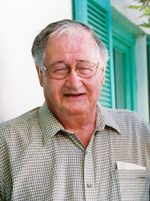Dr David L. Hayman (1929 - 2006)
 Obituary Obituary
David Hayman, who retired as Reader in Genetics in 1992, was closely associated with the University of Adelaide for more than 50 years. In his final year for the B.Ag.Sc. degree at the Waite Institute in 1952, David obtained a splendid grounding in genetics with Professor D.G. Catcheside and George Mayo and Jean Mathieson as Lecturers in the new Department. In 1953 he began a study of cross-incompatibility in the grass Phalaris coerulescens which led to his PhD and a paper sent for publication early in 1956 with his discovery of a novel genetic system with two separate gene loci, both with multiple alleles, controlling incompatibility. A similar discovery was reported for rye in 1954 by Lundqvist in Sweden. Hayman and Lundqvist are now acknowledged as co-discoverers of the genetic basis for incompatibility found in all grass species that have been studied. After several years as a Research Officer in the CSIRO Division of Plant Industry, David came to Adelaide as a Lecturer in Genetics in 1959 and began a big project on marsupial cytogenetics. From studies of chromosome morphology and banding patterns in Australian and South American species, he identified two contrasting themes in marsupial evolution: i) conservation of chromosome number and morphology, and ii) chromosomal fission events leading to an increase in chromosome number. After Bennett and Hope observed very much higher genetic recombination frequencies in males than in females in Sminthopsis crassicaudata, David found (in the first systematic study of meiosis in both sexes of a marsupial) that paralleling this observation, there was pronounced distal localisation of chiasmata in all autosomes at meiosis in females but not in males. He found similar differences in a South American marsupial, suggesting an ancient origin, but not all species are affected. David maintained his interest in incompatibility in P.coerculescens, supervising studies of mutations where the incompatibility has been completely or partially lost and after retirement he worked with Professor Peter Langridge at the Waite Institute in an attempt to clone an incompatibility gene from pollen. David is remembered as an inspiring teacher of cytology and genetics. An excellent supervisor of research students, he always encouraged them to develop and test their own ideas, never forcing his opinions on them. He was very pleased that so many of his students went on to distinguish themselves in scientific work. Whilst Assistant to the Dean of the Faculty of Science (1960-75) and later as Dean, he built lasting friendships with many in the wider university. He served on the University Finance Committee (1982-86), the Wilderness School Council (1969-84) and as President of the Genetics Society of Australia (1979). David enjoyed collecting early maps and books and he recently gave some 17th century texts to the University Library. It thus seems especially fitting that the University has now established the Dr David Hayman Memorial Book Fund, with donations to this fund becoming part of an endowment, the income from which will be used to purchase books for the Library. Contributed by Henry Bennett
|





